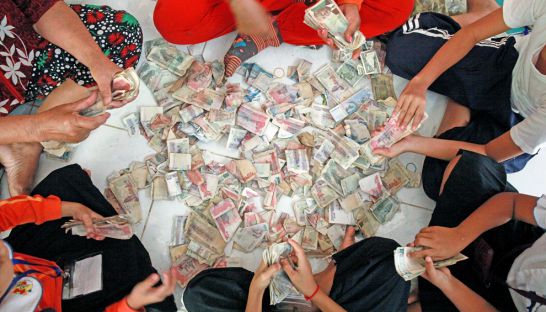Central bank urges riel spending
Central bank urges riel spending
Cambodia’s central bank yesterday again raised the issue of the country’s highly dollarised economy, suggesting that government policies and action plans will be enforced over the long term to promote the use of the riel, giving the National Bank of Cambodia (NBC) more monetary control.

Speaking at the Second NBC Macroeconomic Conference yesterday, Neav Chanthana, deputy governor of the NBC, said that while Cambodia’s economy has reaped the benefits of dollarisation it was also a key challenge now.
“Dollarisation presents risks and vulnerabilities, given the of the economy and financial sector has grown remarkably,” Chanthana said.
Citing the progress made by countries such as Laos, Poland and Turkey to increase circulation of their local currencies, she did not detail how the government’s action plan would increase the use of the riel but said it would be implemented in a phased manner.
“Implementing these measures too soon and all at once would cause capital flight and a black market for foreign currency,” she said.
According to figures released yesterday by the NBC, dollarisation has increased substantially from 36 per cent in 1993 to more than 80 per cent in 2013.
The high level of dollarisation in Cambodia limits the NBC’s power to put in place its own monetary policy, as this is instead determined by the US Federal Reserve. This leaves the central bank with no room to initiate currency devaluations, a tactic often used by economies to make their exports more attractive.
Jayant Menon, lead economist at the Asian Development Bank’s office of regional integration, said investors preferred to invest in dollars, given that it was internationally acceptable and convertible.
“Therefore, imposing the use of riel before it is convertible and confidence in it is higher will negatively affect investor sentiment,” he cautioned.
Menon added that imposing the local currency should “occur naturally” and once the economy overcomes the root causes of dollarisation.
“And when this happens, the riel will operate almost exactly like the dollar does today,” he said.
Recent global economic conditions have caused the Malaysian ringgit, Thai baht and Vietnamese dong to depreciate substantially, whereas the Cambodian riel – which is strongly pegged to the dollar – has remained relatively stable.
An appreciating dollar has put more cost pressures on Cambodia’s export sector, but given the context of recent global events, high dollarisation has helped insulate Cambodia from strong economic headwinds, according to Grant Knuckey, CEO of ANZ Royal Bank.
“We would have seen a lot more volatility and consequent impacts on activity, the likes of which have been apparent in Indonesia and Malaysia,” he said.
The NBC said that in the immediate scenario, export-import companies would be spared any migration to riel use, with it being encouraged across the domestic economy.
Te Taing Por, president of the Federation of Associations for Small and Medium Enterprises in Cambodia, said he welcomed the initiative from the government, adding that small- and medium-d firms would not be affected by an increase in riel usage.
“Local small and medium enterprises will agree on this point. For business payments there is no difficulty in using riels,” he said.
When switching over to riel, the cost of retail items displayed in riel will have many more digits compared to their dollar counterpart. But Taing Por said this should not turn off customers, as countries such as Vietnam display prices in their own currency despite large figures.
“This will not affect business, because we will get used to it as they have in other countries,” he said.














